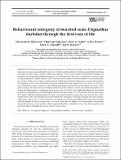Behavioural ontogeny of bearded seals Erignathus barbatus through the first year of life
Abstract
Pinniped pups face special ontogenetic challenges as they are born and receive maternal care on solid substrates (land or ice) but must transition to feeding aquatically following weaning. In this study, Satellite Relay Data Loggers were used to study behavioural ontogeny of bearded seal Erignathus barbatus pups (n = 13) through their first year in Svalbard, Norway. Pups occupied shallow, coastal habitats and were found in areas with intermediate ice concentrations (in seasons with sea ice - late-autumn/winter). Most pups showed exploratory movement patterns that peaked in the weeks following weaning; maximum home range size occurred at 31 to 60 days of age. Thereafter, home range size decreased with pups settling into areas along the coast. Time spent diving, dive duration, dive depth and time at the bottom of dives increased during the first weeks of independence, stabilizing when pups were ~50 d old. Dive depth subsequently decreased to depths comparable to adult bearded seals (by the time pups were ~175 d old). Record maximum dive depth (368 m) and duration (16.5 min) were performed by pups that were 66 and 224 d old, respectively. Time spent hauled out decreased after weaning, with pups hauling out only sporadically after they were 75 d old. Bearded seals pups seem to be physiologically and behaviourally well developed by the time they are two months old. Pups did not display the individually specialized diving behaviour seen in adults, which suggests that they continue to fine-tune their aquatic and other life-skills well past the end of the first year of life.
Citation
Hamilton , C D , Lydersen , C , Fedak , M A , Freitas , C , Hindell , M A & Kovacs , K M 2019 , ' Behavioural ontogeny of bearded seals Erignathus barbatus through the first year of life ' , Marine Ecology Progress Series , vol. 627 , pp. 179-194 . https://doi.org/10.3354/meps13072
Publication
Marine Ecology Progress Series
Status
Peer reviewed
ISSN
0171-8630Type
Journal article
Description
Funding was provided by the Norwegian Research Council (MARE programme, grant number 164940). C.D.H. was funded by the Norwegian Polar Institute’s Centre for Ice, Climate and Ecosystems.Collections
Items in the St Andrews Research Repository are protected by copyright, with all rights reserved, unless otherwise indicated.

